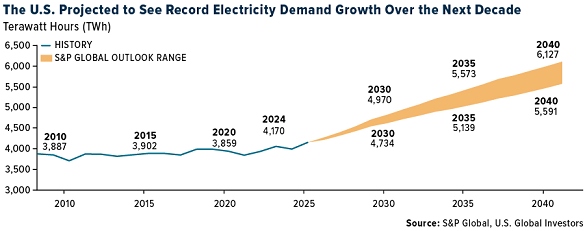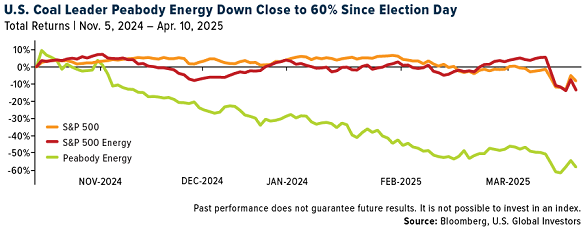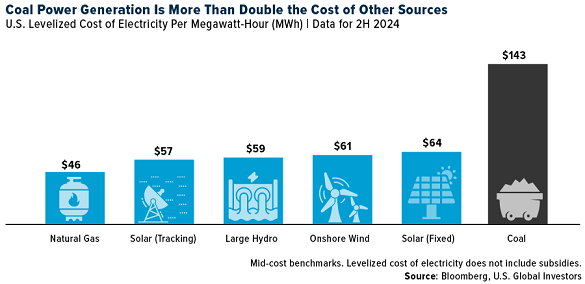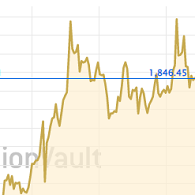The Reality of Trump's Coal Economics
Fossil fuels below 50% of US electricity output...
BETWEEN raising and lowering tariffs on imported goods, President Donald Trump made time to sign an executive order aimed at reviving America's "beautiful clean coal industry", writes Frank Holmes at US Global Investors.
The order outlines an ambitious strategy to reclassify coal as a critical mineral, reopen federal lands to mining, fast-track environmental reviews and provide federal support for coal-fired electricity and coal exports.
The move comes at a pivotal time. Demand for electricity is surging as the US seeks to reindustrialize and build out new infrastructure to support artificial intelligence (AI) data centers, electric vehicles (EVs) and high-performance computing.
According to S&P Global, the US will see greater electricity demand growth in the next decade than in any ten-year period in history.

Shares of Peabody Energy − the largest US coal producer, responsible for mining over 104,000 short tons in 2023 − closed up 9.21% on the Tuesday of Trump's big tariff crash bounce.
That was the company's best one-day increase since 6 November 2024, the day after Trump won his second term. Over the longer term, however, Peabody's stock has plummeted, losing close to 60% of its value since Election Day.

I admire the President's focus on strengthening US energy security. Reliable, affordable power is the bedrock of economic growth and national competitiveness. While I understand his intent, I believe the long-term investment case is moving in a different direction − and it's one that leans heavily toward renewables.
Coal is often described as a powerful energy source, and indeed it helped build the industrial age. But today, coal is struggling to compete on cost. The levelized cost of electricity (LCOE) for new coal plants is more than double that of solar, wind and natural gas, according to BloombergNEF. And that's before factoring in the environmental and public health costs of coal extraction and combustion.
The simple truth is that coal is no longer the cheapest or cleanest option.

The market knows this. Coal's share of power generation in advanced economies has been in steady decline since it peaked in 2007, according to the International Energy Agency (IEA).
In the US, coal fell below 15% for the first time ever in 2024, and the trend is accelerating. The Institute for Energy Economics and Financial Analysis (IEEFA) projects that the remaining 115,000 megawatts (MW) of coal capacity could be shuttered by 2040. Nearly a quarter of the existing US coal fleet is already scheduled to retire by 2029.
Many of the plants still online are operating far below capacity. Reopening closed plants, or extending the lives of aging ones, is highly inefficient. Maintenance costs increase with age, and many units are now over 50 years old. The last large coal plant built in the US came online in 2013, and since then, the pipeline has run dry.
It's no secret that the global energy makeup is transitioning. Coal generation hit a new record high in 2024, largely due to growth in emerging markets, but even in China and India, two of the world's largest coal consumers, ambitious plans are underway to increase cleaner energy. China led the world in solar additions in 2024, while India is scaling up renewables to meet its growing energy needs.
The US saw coal consumption fall 4% last year, on top of a 17% drop in 2023. Meanwhile, renewables are setting new records. Just last month, US wind and solar generation hit an all-time high of 83 terawatt-hours (TWh), while fossil fuels' share of the electricity mix fell below 50% for the first time ever.
It's clear where the wind is blowing. I believe this trend represents an attractive investment opportunity.
Renewable capacity additions around the world surged by 25% last year, led by solar and wind. Solar alone is expected to account for more than half of all new generating capacity in the US this year, with my home state of Texas leading the way. More than a third of all new solar panels is expected to be installed right here.
What's even more compelling is that renewables are now cheaper not just than building new coal plants − they're cheaper than operating most existing coal plants. According to Energy Innovation, 99% of US coal plants could be replaced with new solar or wind at a lower cost.
Again, I agree with President Trump that AI and data centers will be massive energy consumers in the coming years. As executive chairman of HIVE Digital Technologies, I should know. Between now and 2030, electricity consumption by data centers alone is set to more than double to an estimated 945 TWh. Pinning our hopes on coal to meet those needs is a backward-looking solution, I believe.
Coal may see a temporary boost from regulatory relief, and some investors may profit in the short term. But in the long run, I think the writing is on the wall. The global transition to cleaner, cheaper energy is well underway. Investors who want to stay ahead of the curve should follow the data and the money.












 Email us
Email us
